
Alpa Model STC
Welcome to the world of neurotic perfectionism.
There are a multitude of worlds within the photographic community. We shoot many different types of subjects in a myriad of situations, locations, and conditions. No one tool can meet all of our needs, nor should it.
As regular readers know, on this site we try and use and report on a broad range of general purpose cameras, from point-and-shoots to high-end DSLRs . We also write about printers, raw software, monitors, and accessories of various sorts. In other words – all of the tools that we as photographers make use of and are interested in learning about in pursuit of our passion – photography.
At the very pinnacle, both in terms of price and image quality lies the latest generation of medium format digital backs. These devices are the digital equivalent of the 4X5″ and 8X10″ view cameras that we used for advertising, product and landscape shooting in the days of film.
There are some photographers who wax nostalgic for sheet film and large format cameras. After having schlepped a variety of LF camera up hill and down dale over the years I have to confess that there is little about them that I miss. I especially don’t miss warped sheet film holders, inaccurately positioned ground glass focusing screens,glasslessnegative carriers on enlargers, or equally frustratingglassnegative carriers for that matter.
The point of this little tirade is that the whole optical chain – from sheet film that wouldn’t lie flat, to imprecise holders, to badly adjusted ground glasses – all conspired to make achieving optimum sharpness very difficult indeed. Not impossible, just a real struggle.
Alpa
There is one company that I am aware of that has devoted themselves to meeting the needs of the neurotic perfectionist photographer in the digital era. That’s the Swiss camera maker Alpa. During the middle years of the 20 th Century the then Alpa company made some of the most fascinating high-end 35mm SLRs . But by 1990 they, like most European camera makers, had succumbed to the major mass market companies from the Far East.
In 1996 though the famous Alpa brand name was purchased by a small team of entrepreneurs bent on producing the highest quality medium format technical cameras possible. Today that company, run by Ursula Capaul , Thomas Weber, and André Oldani , has achieved that goal.
Before going further wi th the review I should disclose a few things that readers are bound to want to know. Firstly, Alpa is an advertiser on this site. They became so in part becauseLuminous Landscapebusiness partner and contributor Mark Dubovoy is an ardent Alpa user, and has developed a strong relationship wi th that company. Of course that our Forum is possibly the world’s largest on-line venue for discussion by medium format digital photographers also has a bit to do wi th it.
Mark and I have been shooting together many times, and whenever Mark would use his Alpa system on one of these shoots, or on workshop that we were teaching together, I would be fascinated by these beautifully built cameras.
Mark has also written a number of articles for this site about Alpa and its products in the past. This includes anAlpa TC Field Report, a further field reportproduct update, andan initial reporton the STC model and HPF focusing rings.
I resisted the siren call of the Alpa for several years though. This was because of my experience using digital backs on other technical cameras. For a time I had used aCambo Wide DS, and then aLinhof 679CS, but always ended up frustrated by the issue of framing and focusing when using a digital back.
As a long-time view camera user (I was once the product manager for Sinar view cameras in Canada, and also taught view camera technique at the college level), I found that the problems when using a medium format digital back on a technical camera were, for me at least, an obstacle that I couldn’t overcome.
When it came to composing the shot, I never found a separate optical viewfinder terribly satisfactory. The real issue though is focusing. Wi th a 4X5″ or larger camera accurate focusing wi th an appropriate magnifier against the groundglass is straightforward. Wi th a 6X6cm or smaller ground glass, this is much more difficult. Also, a sliding carrier for an MF back is bulky, and really makes field use problematic, in addition to the fact that these sliding mechanisms are prone to inaccurate positioning and misalignment.
As a consequence I eventually gave up on using my Phase One backs on a technical camera, continuing to work with a Phase 645 system instead. Some people seemed to be able to make technical cameras work for landscape and nature shooting, but it just wasn’t my idea of a good time.
In January, 2011 with the announcement of the Phase One IQ series backs all of this has changed.(See my first-look report). The IQ back’s Live View and on-screen Focus Confirmation mean that inaccurate external viewfinders and bulky sliding ground glass backs on technical cameras are a thing of the past.
I expect to be field testing a production Phase One IQ180 in early May, and will have a complete report here shortly thereafter – including of course use wi th an Alpa STC system.
So – wi th an IQ 180 on the way (trading in my P65+) I knew that it was time for a technical camera again. Given that Mark had nothing but praise for Alpa , and they were already one of our advertisers, I decided to take the plunge.
As this is being written, as mentioned above, I am still waiting for my IQ180 back, which was the motivator for the purchase. But, I wanted to cover the things that make the Alpa stand apart from the mainstream of technical cameras, and which make them the ultimate tool for the neurotic perfectionist (said with humour and affection – since I’m one of them).
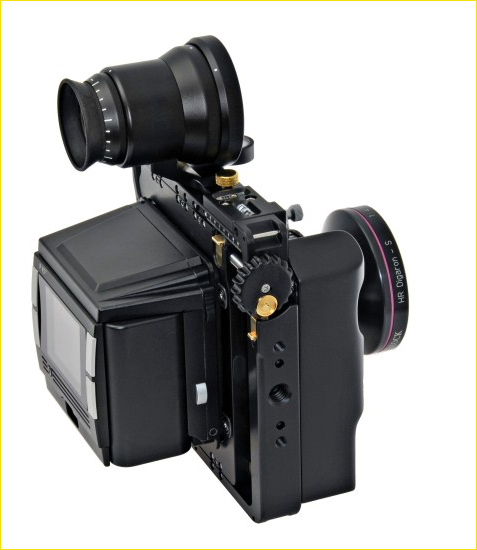
Alpa STC wi th Phase One back and zoom optical viewfinder
The STC
Alpa has a number of differentcamera bodies. All feature complete interchangability of lenses, back interfaces and most accessories. Which one to choose is simply a matter of determining your particular needs.
The one I selected to purchase is the newSTC (Stitch / Shift Travel Compact). This differs from the smallest and lightest model, the TC, by adding shift capability. For pano work the STC makes shooting three exposures – left – center – right – as quick as it takes to move the roller-bearing-slick mount from one side to the other and recock the shutter, (center is detented and lockable). For use in a shift, or rise and fall application, there is a micrometer knob wi th scales built in. Otherwise the STC is essentially identical to the already very popular TC model.
You can switch from vertical to horizontal shooting by rotating the back and adapter plate 90 degrees. But to change the movement from shift to rise/fall you have to rotate the camera body. You can do the latter without rotating the tripod head by either using one of the pre-drilled holes on the side of the camera for the tripod screw or for another tripod head adapter plate. You can obviously also use an L bracket.
There are two different grips available – “rosewood natural” and a black synthetic “soft-touch” material. There are mounting holes drilled on all four faces of the body, and so a variety of accessories can be mounted, including viewfinders. I particularly like the iPhone holder, which along wi th an Alpa -customized App turns the phone into a terrific LCD viewfinder.
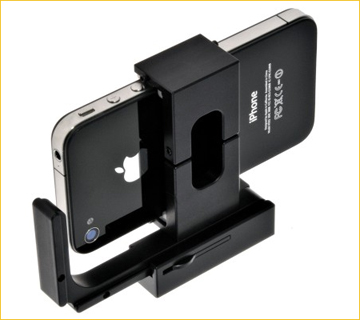
Alpa iPhone holder
Shimming – That Was Then and This is Now
A medium format back on a contemporary technical camera, as compared to a sheet film camera (or even curled roll film), is potentially a superbly precise device. The surface of the sensor is (theoretically at least) perfectly flat, and remains so for the life of the product. Camera bodies are similarly of precision manufacture, as are lenses. Right?
Well – not so fast. Indeed a number of exacting photographers have discovered that there’s a potential fly in the ointment. A very large fly, in fact. Contemporary high pixel count backs (39MP and above) are so demanding of precision sensor alignment within the back, of the back to the body, and of the body to the lens, that while results may well appear to be excellent, they frequently are discovered not to be as precise as one might wish, or of which the equipment is ultimately capable.
These alignment issues are well known in the less demanding 35mm camera segment as well. My review ofLensAligndiscuss this, and also how it is addressed on pro DSLRs . Mark Dubovoy also had a follow-up report on theLensAlign MKII andfurther thoughtson the topic in another essay.
$50,000 or so of camera gear can be rendered less than perfect in its output by an error of as little as 1/100 of a millimeter. Regrettably that level of precisions is simply unachievable in modern camera production, regardless of who the manufacturer might be. (Except maybe Leica 🙂) In other words, the degree of precision needed to extract what a 39, 60 or 80 Megapixel back may be capable of isn’t within the ability of mass production manufacture.
Frankly – I was cynical about needing or even achieving this level of precision. Alpa states that a difference of 1/100 th of a millimeter is visible, and provides a shim kit wi th each MF back adaptor for their cameras to achieve this level alignment.
When I got my Alpa STC I attached my P65+ and did some test shooting, while I familiarized myself with the camera body and lens system. Looking at the files on my 30″ monitor I was very pleased. Things looked great – similar to what I had been getting with my Phase DF camera body.
But then I spent part of an afternoon shimming the back. I went to the roof of a downtown parking structure with a clear view of construction towers and hydro power lines about 3km away. I tethered the back to my 15″ Mabook Pro which was inside the shade of the car, and proceeded to shim the back – inserting a shim, taking a shot, and comparing it to the previous one.
The only time consuming part is removing the adaptor from the back and camera, unscrewing the retaining plate, and carefully removing and re-inserting shims. It’s not difficult; just time consuming.
But in the end I found that Alpa is right – onecansee the difference of 1/100th of a millimeter in back alignment. And when I got home and looked at images at 100% on my 30″ monitor I was more than pleased and surprised at the improvement in image quality.Greathad turned intofantastic!
(I will be doing a video demonstration of shimming a production IQ180, and this will appear as part of my follow-up review of that camera in May).
The back adaptor (available for all major brand MF backs) is made of two interlocking parts with a variable space between them that can hold a shim, or multiple shims, to increase or decrease the spacing between the sensor and the lens’ focal plane. A set of extremely thin metal shims, ranging between .5mm and .01mm are provided. (Watch out for the thinner shims if it’s windy. They are as thin as a butterfly wings and can easily blow away).
A product like LensAlign can’t be used on a camera that doesn’t use autofocus . The way a DSLR is adjusted is – a correction factor is found for a particular lens / body combination and this number is entered on the camera. The body’s AF unit from then on automatically applies this correction factor whenever that particular lens is used. Obviously only cameras wi th the ability to input an AF correction factor can be aligned, and currently this means only top-of-the-line pro-grade DSLRs from Canon, Nikon, and Sony.
To my knowledge no MF camera has this adjustment capability, and the Alpa is the only MF technical camera to offer a shimming solution for MF backs.
Lenses
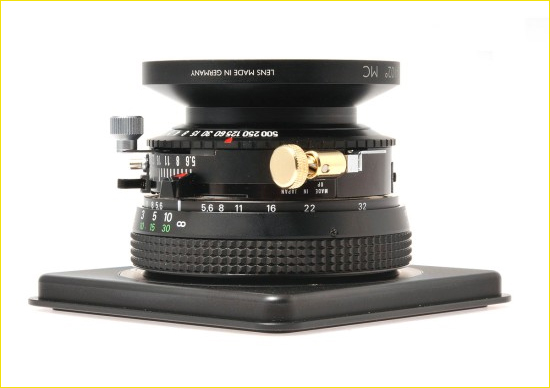
Many technical and view cameras use a traditional bellows body for adjusting the distance between the lens and the back. This works well, and allows just about any lens to be mounted on a standard lens board and attached. It also makes rear standard and front standard movements easier to design and implement, though in turn this makes the camera bulkier.
Alpa feels that this lacks the precision needed, and therefore lenses for these cameras are supplied in a helical mount. Using a helical mount also helps make the cameras smaller and lighter. Lenses from bo th Schnieder and Rodenstock are available through Alpa; some from these company’s regular lens line, and others specifically made for Alpa .
The lenses I chose were theSchneider APO- Digitar f/5.6 43mmand theAPO- Digitar f/5.6 120mm Nin a short mount. These are roughly equivalent to 35mm and 90mm in full-frame DSLR terms, and are my most commonly used focal lengths. For wider and longer lenses wi th the P65+ and eventually the IQ180 I’ll stick wi th my Phase One 645 system, since I want to keep the Alpa kit down to a small backpack. It’s all too easy to keep adding lenses, as every photographer knows.
I am told that all lenses purchased from Alpa are individually adjusted and calibrated following Alpa’s and the manufacturer’s specifications. This adjusting and calibrating is done while the lens is rotating – so the adjustments is not based just on one point in the center of the lens. The reason for this is that during rotation Alpa can discover any decentering, which is not possible by using a simpler process, as is done by the lens manufacturers themselves.
Alpa has this done by both Schneider and Rodenstock, at Alpa’s expense, and they have told me that to their knowledge no other reseller of those company’s lenses takes this extra step.
Additionally, all supplied lenses have Alpa’s unique shutter blade interlock and size 0 shutters, with an Alpa shutter release button for hand-held shooting. These lenses have either an original Schneider or Rodenstock helical mount, or in the case of some longer focal length Schneider lenses, an original Linhof size 1 helical mount, offering a very long movement, and so providing a relatively short minimum distances. My 120mm Schneider, for example, can be focused down to just 1.2 m, and has focusing gradations so fine that an HPF ring isn’t even needed.
All of this makes Alpa lenses about $1,000 more expensive than an off-the-shelf lens of the same focal leng th, but for the neurotic perfectionist in search of the best this is the way to go.
Short Mount Lenses and the Tilt / Swing Adaptor

Alpa body spacer / tilt-swing adaptor
You may note that I chose a “short mount” for the 120mm lens. This means that either an extender is needed to focus to infinity, or better yet anAlpa Tilt / Swing Adaptorcan be used. This provides the 34mm of extension needed for infinity focus but more importantly the facility for up to 24 deg (+/- 12 deg) of tilt or swing when used wi th an Alpa short mount lens, beginning at 80mm focal leng th and going out to 250mm. (No, this can’t be used at infinity with lenses wider than 80mm).
Because of the symmetrical design of the Alpa 12 series of cameras this adaptor can be used on either the front or the back of the body. While you’ll usually want to use the Scheimpflug effect on the front standard, it can be convenient to put the adaptor on the rear instead when using it simply as an extension tube, as this helps to make for a better balance, especially wi th longer lenses.
HPF Rings and Lasers
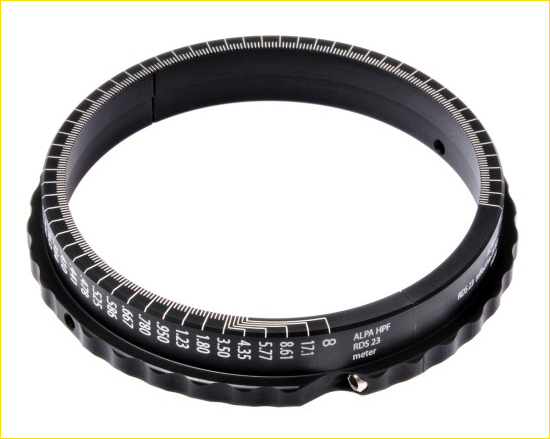
Alpa High Precision Focusing Ring
Being the sticklers for precision that they are (neurotic perfectionist?), the normal focusing scales that have been on Alpa’s lens mounts were not precise enough for work wi th a laser rangefinder. Alpa therefore came up wi th what they call their High Precision Focusing Rings (HPF). These are available for all Schneider and Rodenstock wide angle to short tele lenses which feature size 0 shutters and helical mounts. They are available calibrated in either feet and meters and can be user installed.
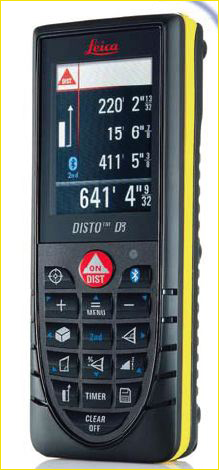
Leica Disto 5 Laser Rangefinder
The reason for these is because, as mentioned above, it is very difficult to focus wi th great accuracy on a small groundglass . And, when working in the field (nature and landscape), a groundglass wi th either a sliding back, or one which involves taking the back on and off, is slow and not much fun to use.
The solution is to use a laser rangefinder such as the Leica Disto 5. This provides a measurement range and accuracy of from 0.05 to 200 m (0.16 ft up to 650 ft) wi th typical accuracy of ± 1.0 mm (± 0.04 in). When used together wi th an Alpa lens wi th an HPF ring attached absolute focusing accuracy is possible in just about any situation and at any distance. Just point the device at the subject and press the button. Sighting is either by observing the red laser dot being thrown on the subject, or by using the built-in video screen and target sight.
Read off the distance (accurate to within a single millimeter) and set this on the lens’ HPF ring. It takes longer to describe than to do.
I was a bit cynical about this when first shown to me by Mark, but I decided to trust my friend, and I can now say that this works perfectly. The combination of an HPF ring and the Leica laser rangefinder produces a higher level of focusing accuracy than any method I’ve ever used, including AF on my Phase One 645 camera.
Fit and Finish
Frankly, the price of an Alpa camera, lenses, and accessories can make one gulp. Of course if you’re using a high resolution medium format back then you’re already accustomed to sticker shock. But, when you pick up an Alpa and use its sliders, levers and other controls, and look closely at the overall fit and finish of the body and the materials used, you’ll understand where your money has gone. It would be a cliche to write that Alpa cameras are made wi th the precision of a fine Swiss watch, but indeed they are.
Are they wor th the money? To my mind they are, and not just because they are beautifully made. Their real value is found when one is used in conjunction wi th a high resolution digital back. An Alpa is able to extract the ultimate image quality that these devices are capable of. And that’s exactly what us neurotic perfectionists are looking for.
April, 2011
You May Also Enjoy...
Hasselblad H3DII-50 Announced
Hasselblad H3DII-50H3DII-50Hasselblad has announced theH3DII-50, its latest medium format camera and back. The H3DII-50 is the same camera as before, it's really the back that's
Death Valley 1999
This subject is featured inIssue #1of The Luminous Landscape Video Journal Death Valley Moonrise, 1999 We had planned this trip to coincide not only with the
